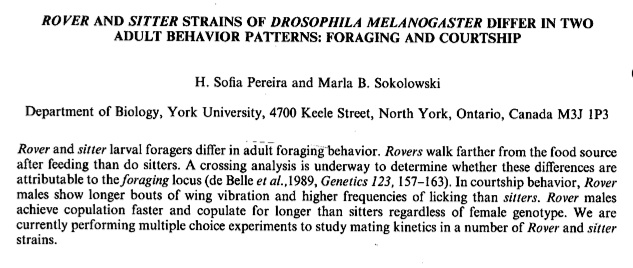Animal Behavior
Biology 342 Fall 08
Week 5 - Oct 1 & 2
Behavioral Genetics. Rover/Sitter
LINK to FLY LAB HANDOUT
GENERAL EXPECTATIONS
Students will work in pairs to quantify crawling distance for Drosophila larvae
on normal food substrate.
This lab will be a bit messy and smelly (yeast paste) so dress accordingly.
For this portion of the lab there is an expected result, but it will be
paired with data from next week in order to ask a novel (and potentially
publishable) question.
Student pairs will develop a protocol to assay mating behavior in these two strains. Below you will see the abstract for a meeting that was presented over 15 years ago. This abstract suggests that the foraging locus may also affect mating behavior. It is known that the foraging gene is pleitropic (do a web of science search to find the other behaviors that have been reported) but no published work has followed up on the mating behavior. A very rough protocol will be provided, and students will be expected to use that in order to do a pilot study and then write a more detailed protocol.

Since We aren't doing genes and behavior in class right now, as I had planned you may also wnat to READ:
Sokolowski (2001) Drosophila: Behavior meets Genetics. Nature Genetics 2:877-892.
READ:
Osborne, K.A., Robichon,
A., Burgess, E., Butland, S., Shaw, R.A., Coulthard, A., Pereria, H.S.,
Greenspan, R.J. and Sokolowski, M.B. (1997) Natural
behavior polymophism due to a cGMP-dependent protein kinase of Drosophila.
Science 277:834-836.
Fitzpatrick, M.J., Feder,
E., Rowe, L. and Sokolowski, M.B.(2007) Maintaining
a behavior polymophism by frqeuency-dependent selection on a single gene.
Nature 447:210213.
EXTRA:
Pereira, H.S., MacDonal,
D.E., Hilliker, A.J. and Sokolowski, M.B.(1995)
Chaser (Csr), a new gene affecting larval foraging behavior in Drosophila
melanogaster. Genetics 141:263-270.
TO BE EVALUATED
All raw data for the primary experiment MUST be entered to the class spread sheet before you leave lab today. There will be no statistical analysis this week.
Each student pair will perpare a detailed lab protocol to assay mating behavior in these two strains
This lab protocol should include:
1 -
A short introduction with a few references
for further reading.
2 -
A list of supplies that are needed.
3 - A protocol that is sufficiently
detailed to be followed by students.
4 -
Instructions for data analysis.
Every student is expected to keep their own lab notebook and not rely
on the notebook of a labmate, however when data is recorded it need not
be copied, a clear statement of where the data is recorded is sufficient.
Lab notebooks will be evaluated!